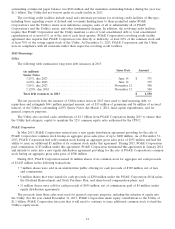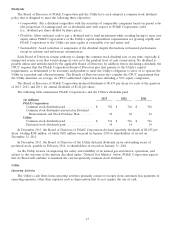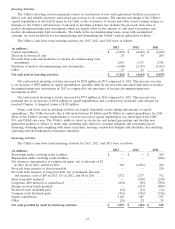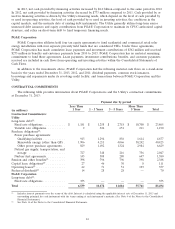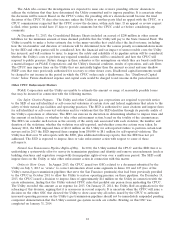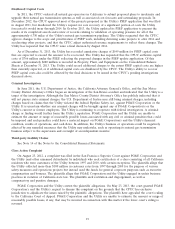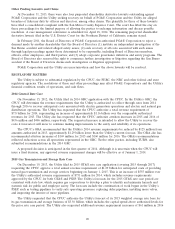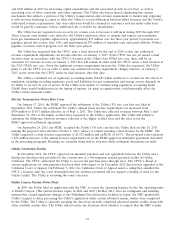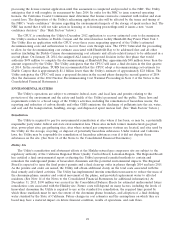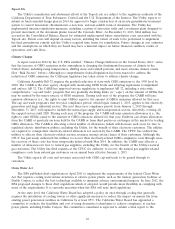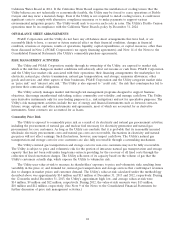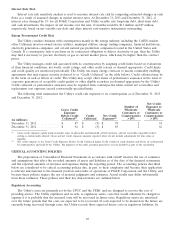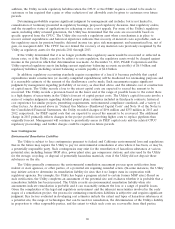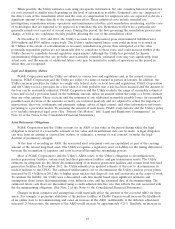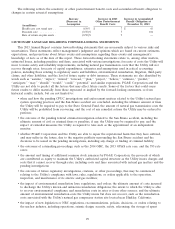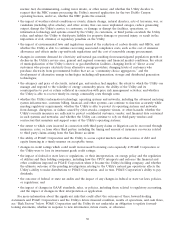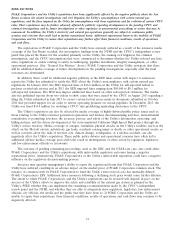PG&E 2013 Annual Report Download - page 28
Download and view the complete annual report
Please find page 28 of the 2013 PG&E annual report below. You can navigate through the pages in the report by either clicking on the pages listed below, or by using the keyword search tool below to find specific information within the annual report.processing the license renewal application until this assessment is completed and provided to the NRC. The Utility
anticipates that it will complete its assessment by June 2014. In order for the NRC to issue renewed operating
licenses, the California Coastal Commission must determine that license renewal is consistent with federal and state
coastal laws. The disposition of the Utility’s relicensing application also will be affected by the terms and timing of
the NRC’s ‘‘waste confidence’’ decision regarding the environmental impacts of the storage of spent nuclear fuel. The
NRC has stated that it will not take action in licensing or re-licensing proceedings until it issues a new ‘‘waste
confidence decision.’’ (See ‘‘Risk Factors’’ below.)
The CPUC is considering the Utility’s December 2012 application to recover estimated costs to decommission
the Utility’s nuclear facilities at Diablo Canyon and the retired nuclear facility Humboldt Bay Power Plant Unit 3.
The Utility files an application with the CPUC every three years requesting approval of the Utility’s estimated
decommissioning costs and authorization to recover those costs through rates. The CPUC bifurcated the proceeding
to allow for the decommissioning cost estimate associated with Humboldt Bay to be addressed first and all other
matters (including the Diablo Canyon decommissioning cost estimate and all rate-related issues) to be addressed in a
second phase. On January 28, 2014, the assigned ALJ issued a proposed decision in the first phase that would
authorize $679 million to complete the decommissioning at Humboldt Bay, approximately $48 million lower than the
amount requested by the Utility. The Utility anticipates that the CPUC will issue a final decision in the first quarter
of 2014. In the second phase, TURN has recommended that the CPUC adopt a decommissioning cost estimate for
Diablo Canyon that is approximately $1.1 billion lower than the Utility’s estimate of approximately $2.8 billion. The
Utility anticipates the CPUC will issue a proposed decision in the second phase during the second quarter of 2014.
(See the discussion of the 2012 Nuclear Decommissioning Cost Triennial Proceeding in Note 2 of the Notes to the
Consolidated Financial Statements.)
ENVIRONMENTAL MATTERS
The Utility’s operations are subject to extensive federal, state, and local laws and permits relating to the
protection of the environment and the safety and health of the Utility’s personnel and the public. These laws and
requirements relate to a broad range of the Utility’s activities, including the remediation of hazardous wastes; the
reporting and reduction of carbon dioxide and other GHG emissions; the discharge of pollutants into the air, water,
and soil; and the transportation, handling, storage, and disposal of spent nuclear fuel. (See ‘‘Risk Factors’’ below.)
Remediation
The Utility is required to pay for environmental remediation at sites where it has been, or may be, a potentially
responsible party under federal and state environmental laws. These sites include former manufactured gas plant
sites, power plant sites, gas gathering sites, sites where natural gas compressor stations are located, and sites used by
the Utility for the storage, recycling, or disposal of potentially hazardous substances. Under federal and California
laws, the Utility may be responsible for remediation of hazardous substances even if it did not deposit those
substances on the site. (See Note 14 of the Notes to the Consolidated Financial Statements.)
Hinkley Site
The Utility’s remediation and abatement efforts at the Hinkley natural gas compressor site are subject to the
regulatory authority of the California Regional Water Quality Control Board, Lahontan Region. The Regional Board
has certified a final environmental report evaluating the Utility’s proposed remedial methods to contain and
remediate the underground plume of hexavalent chromium and the potential environmental impacts. The Regional
Board is expected to issue the final project permits and a final clean-up order in phases through 2014 and into 2015.
As the permits and order are issued, the Utility will obtain additional clarity on the total costs associated with the
final remedy and related activities. The Utility has implemented interim remediation measures to reduce the mass of
the chromium plume, monitor and control movement of the plume, and provided replacement water to affected
residents. (See Note 14 of the Notes to the Consolidated Financial Statements for additional information.) At
December 31, 2013, $190 million was accrued in the Consolidated Balance Sheets for estimated undiscounted future
remediation costs associated with the Hinkley site. Future costs will depend on many factors, including the levels of
hexavalent chromium the Utility is required to use as the standard for remediation, the required time period by
which those standards must be met, the extent of the chromium plume boundary, and adoption of a final drinking
water standard by the State of California. Future changes in cost estimates and the assumptions on which they are
based may have a material impact on future financial condition, results of operations, and cash flows.
22


